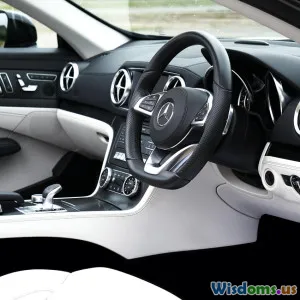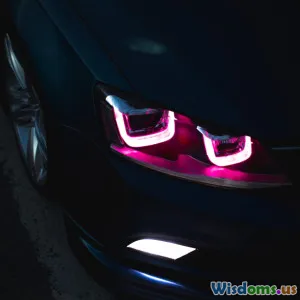
What Tesla Taught the Auto World About Entertainment Screens
8 min read Explore how Tesla revolutionized automotive entertainment screens, blending innovation, usability, and driver experience to reshape in-car digital interaction. (0 Reviews)
What Tesla Taught the Auto World About Entertainment Screens
Tesla has not only disrupted the automotive industry with its electric powertrains and autonomous driving capabilities but also with its trailblazing use of entertainment screens inside vehicles. Its revolutionary approach to in-car digital displays fundamentally changed expectations around user engagement, safety, and multimedia access. In this article, we unravel the lessons Tesla imparted to the automotive world regarding entertainment screen technology—lessons that continue to inspire innovation across manufacturers globally.
Introduction
Not long ago, infotainment screens in vehicles were modest additions—small touchscreen panels or embedded LCD screens used mostly for navigation or radio displays. Tesla catapulted these systems into the spotlight, turning the car’s central touchscreen into more than just an infotainment hub; it became the nerve center of the vehicle.
Tesla’s journey from the first Model S release in 2012 to current models highlights an evolution not just in hardware but in how software and entertainment converge in automotive design. The company showed that entertainment screens could enhance the driving experience without distracting drivers or compromising safety.
What are the critical takeaways from Tesla’s vision? How did the company’s choices influence competitors and the future of car entertainment systems? Let’s dive deeper.
Tesla’s Entertainment Screen Innovations
Immersive Display Size and Orientation
At the time of its debut, Tesla’s Model S shocked the industry with its massive 17-inch portrait-oriented touchscreen—significantly larger than the typical manufacturer screens, usually landscape and around 7 to 10 inches.
This vertical screen format maximizes visible information, making it easier for users to read longer content, view controls more clearly, and interact with multiple functions simultaneously. The widescreen but vertically tall display imitates the experience of a tablet, blending familiar technology with automotive controls.
Integration of Vehicle Controls and Entertainment
Unlike traditional cars with physical knobs, buttons, or switches for climate, lights, and stereo, Tesla centralized virtually every function into the touchscreen. This radical consolidation reduced physical cabin clutter, enabling a minimalist and futuristic cockpit.
Users could change entire vehicle settings, access energy consumption stats, or alter seat heating through intuitive menus—something that was previously scattered across various panels in a car.
Advanced Software Interface with Over-the-Air (OTA) Updates
Tesla’s entertainment screens are no longer static after purchase. The software regularly receives OTA updates, which can add new features, improve performance, and even introduce fresh games.
For example, the "Tesla Arcade" launched as part of notable updates introduced playable games like ‘Cuphead’ and ‘Beach Buggy Racing’ on the center screen. The ability to update software throughout the vehicle’s lifetime is a significant departure from traditional physical upgrades or dealer visits.
This ensures that the entertainment system evolves alongside user expectations and technical advancements without costly hardware changes.
Media Integration and Streaming
Tesla actively integrated popular streaming services like Netflix, YouTube, Hulu, and Spotify directly into their screens. Passengers waiting during charging can enjoy high-quality video or music without additional devices.
Providing comprehensive entertainment options considering future vehicle autonomy scenarios posits the screen not just for the driver but the entire traveling party.
Customization and Personalization Features
Tesla allows users to customize the display layout, themes, and frequently used functions. This personalization helps reduce friction, making digital interactions more comfortable and user-centric.
Through voice commands combined with screen interaction, Tesla demonstrated how multifaceted input could be managed while focusing on the road.
Lessons for the Auto Industry
Prioritizing User Experience (UX) Over Tradition
Tesla’s rejection of conventional knobs and buttons encourages manufacturers to rethink driver interaction complexity. Tesla's screens are designed for intuitive use, accessibility, and minimizing distractions, enhancing safety as per studies on cognitive load in driving behavior.
Industry Insight: Companies like Ford with its SYNC system, Mercedes-Benz with MBUX, and BMW’s iDrive have incorporated larger, more integrated screens inspired partly by Tesla’s lead, incorporating AI-driven interfaces and voice recognition for safety and ease.
Balancing Entertainment with Safety Regulations
A common concern with large touchscreens is distraction. Tesla combats this through smart software limitations—blocking certain video content while driving, encouraging use during charging, and integrating autopilot features reducing driver attentiveness demands during some conditions.
Regulatory bodies worldwide are developing guidelines influenced by Tesla’s experiences to ensure screens don’t become hazards.
Software-Defined Vehicles and the Screen as the Control Hub
Tesla’s focus on software over hardware hardware flexibility marks a new paradigm. The entertainment screen functions like a smartphone or tablet in usability but controls critical systems.
This software-centric approach allows for heavy customization, improves after-sale user experience, and extends hardware utility longer than conventional car architectures.
Expanding the Screen's Role Beyond Entertainment
Tesla views its screen as integral not just for infotainment but as a fundamental interface with vehicle health, navigation, climate control, and driver assistance.
This all-in-one interface is a blueprint for future vehicles, which seamlessly meld driver assistance systems with entertainment and vehicle diagnostics for a holistic experience.
Real-World Impact and Consumer Reception
Tesla’s screen innovations proved commercially successful, with many buyers praising the usability and high-tech feel. The Tesla brand now often involves software and UI expectations as much as performance specs.
Market Data: A 2023 study by J.D. Power noted Tesla’s infotainment system scores above industry average in consumer satisfaction, particularly for responsiveness and feature richness.
Furthermore, traditional automakers accelerated their digital strategy witnessing Tesla’s appeal, making large, responsive, connected screens standard in mid-to-upper tier vehicles.
Tesla’s success is a driving force behind the rise of ‘smart cockpit’ technology, blending entertainment, safety features, and connected services.
Challenges and Criticisms
While Tesla’s bold use of touchscreen entertainment screens stands out, it’s not free from critique:
- Overdependence on Touchscreens: Some drivers find it cumbersome to perform routine actions without tactile feedback.
- Distractions: Despite software safety protocols, critics argue that large entertainment options can lure driver focus away from roads.
- Learning Curve: Users familiar with conventional physical controls may initially struggle without tactile buttons.
Tesla continuously refines user interfaces and integrates voice commands to alleviate these concerns, an ongoing process within the tech.
Rate the Post
User Reviews
Other posts in Infotainment Systems
Popular Posts
















